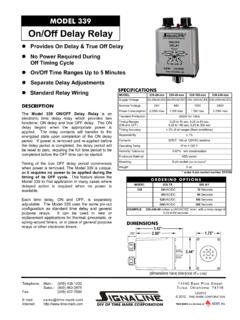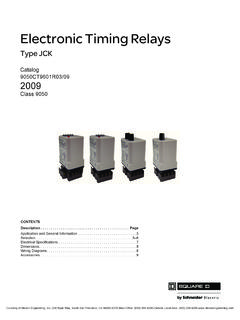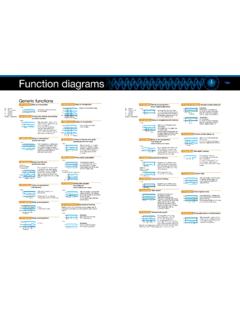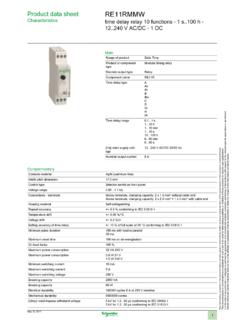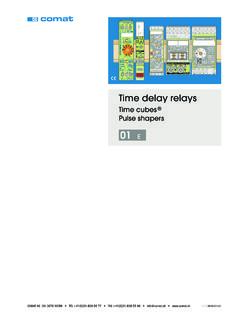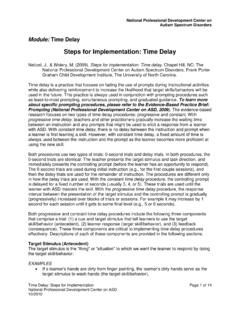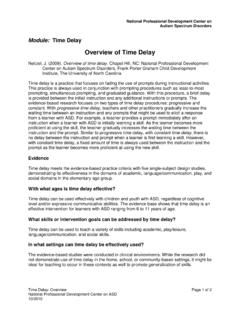Transcription of Time-delay electromechanical relays - ibiblio.org
1 Time-delay electromechanical relaysThis worksheet and all related files are licensed under the Creative Commons Attribution License,version To view a copy of this license, visit , or send aletter to Creative Commons, 559 Nathan Abbott Way, Stanford, California 94305, USA. The terms andconditions of this license allow for free copying, distribution, and/or modification of all licensed works bythe general and methods for learning about these subjects (list a few here, in preparationfor yourresearch):1 QuestionsQuestion 1 What does thenormalstatus of an electrical switch refer to? Specifically, what is the difference betweenanormally-openswitch and anormally-closedswitch?file 02363 Question 2 Explain what atime- delay relayis, and how it functionally differs from a regular electromechanical 03132 Question 3A special class of electromechanical relays calledtime-delayrelays provide delayed action, either uponpower-up or power-down, and are commonly denoted in ladder logic diagrams by TD or TR designationsnear the coil symbols and arrows on the contact symbols.
2 Here is an exampleof a Time-delay relay contactused in a motor control circuit:L1L2TD1 Stop RunTD1 Motor3 secondsIn this circuit, the motor delays start-up until three secondsafterthe switch is thrown to the Run position, but will stop immediately when the switch is returned to the Stop position. The relay contactis referred to asnormally-open, timed-closed, or NOTC. It is alternatively referred to as anormally-open, how the arrow symbol indicates the nature of this contact s delay , thatdelay occurs duringclosure but not during 031412 Question 4 Match the following Time-delay relay contact type symbols and labels: Normally-open, timed-closed Normally-open, timed-open Normally-closed, timed-closed Normally-closed, timed-openfile 03133 Question 5 Match the following Time-delay relay contact type symbols and labels: Normally-open, on- delay Normally-open, off- delay Normally-closed, on- delay Normally-closed, off-delayfile 031343 Question 6 Time-delay relaysare important circuit elements in many applications.
3 Determine what each of thelamps will do in the following circuit when pushbutton A is pressed for 10 seconds and then released:L1L2 ATD1 Lamp #1 Lamp #2 Lamp #3 Lamp #44 secondsTD1TD1TD1TD1 Timing diagram:ALamp #1 Lamp #2 Lamp #3 Lamp #4 time scale (1 second per mark)onoffonoffonoffonofffile 023814 Question 7A simple Time-delay relay may be constructed by connecting a large capacitor in parallel with the relaycoil, like this:Contact terminalsCoil terminalsExplain how this circuit works, and also determine what type of Time-delay relayfunction is providedby it (NOTO, NOTC, NCTO, or NCTC).file 03139 Question 8A simple Time-delay relay may be constructed by connecting a large capacitor in parallel with the relaycoil, like this:Contact terminalsCoil terminalsExplain how this circuit works, and also determine what type of Time-delay relayfunction is providedby it (NOTO, NOTC, NCTO, or NCTC).file 031405 Question 9An electric motor is used to power a large conveyor belt. Before the motor actually starts, a warningsiren activates to alert workers of the conveyor s forthcoming action.
4 The following relay circuit accomplishesboth tasks (motor control plus siren alert):L1L2 StartStopCR1 OLCR1TD1M1M1TD1 SirenStudy this ladder logic diagram, then explain how the system 031466 Question 10 Large electric motors are often equipped with some form ofsoft-startcontrol, which applies powergradually instead of all at once (as in across the line starting). Here is an example of a simple soft start control system:L1L2 StartStopCR1 OLCR1TD1M1TD1M2M2motorTo 3-phasepower sourceM1 OLM2 RAnalyze this ladder logic diagram, and explain how it starts up the electric motor more gently than an across-the-line starter 031497 Question 11 The following ladder logic diagram is for a reversing motor control circuit:L1L2M1motorTo 3-phasepower sourceM1 OLOLF orwardReverseM2M2M1M2M1M2 StopStudy this diagram, then explain how motor reversal is accomplished. Also, identify the function ofeach M contact in the control circuit, especially those normally-closed contacts in series with the motorstarter consider the following modification made to the reversing motor control circuit (motor and powercontacts not shown here):8L1L2M1 OLForwardReverseM2M2M1M1M2 StopTD1TD2TD2TD1 What extra functionality do the Time-delay relays contribute to this motor control circuit?
5 File 03148 Question 12An electric motor is used to power a large conveyor belt. Before the motor actually starts, a warningsiren activates to alert workers of the conveyor s forthcoming action. The following relay circuit is supposedto accomplish both tasks (motor control plus siren alert):L1L2 StartStopCR1 OLCR1TD1M1M1TD1 SirenUnfortunately, there is a problem somewhere in this circuit. Instead of activatingthe siren beforestarting the motor, there is silence. The motor s start is still delayed bythe correct amount of time , butthe siren never makes a sound. Identify some possible causes of this problem. Also,identify portions of thecircuit you know to be functioning 031479 Question 13An electric motor is used to power a large conveyor belt. Before the motor actually starts, a warningsiren activates to alert workers of the conveyor s forthcoming action. The following relay circuit accomplishesboth tasks (motor control plus siren alert):L1L2 StartStopCR1 OLCR1TD1M1M1TD1 SirenHowever, this circuit is poorly designed.
6 Although it works just fine under normal conditions, it maynot do what it should in the event of an overload heater trip (if the normally-closed OL contact opens).Explain what is wrong with this 04028 Question 14 Suppose you needed to build a circuit that pulsed a lamp on and off (once) when a pushbutton is pressedand held. In other words, you wanted the lamp to do this:LamppulsePushbuttonDraw a ladder logic diagram for a circuit that would fulfill this function, using atleast one 0313610 Question 15 Suppose you needed to build a circuit that pulsed a lamp on and off (once) when a pushbutton isreleased. In other words, you wanted the lamp to do this:LamppulsePushbuttonDraw a ladder logic diagram for a circuit that would fulfill this function, using atleast one 03137 Question 16 Suppose you needed to build a circuit that delayed the energization of a lamp when the button waspushed, and also delayed its turning off when the button was released. In other words, you wanted the lampto do this:onoffLampon delayoff delayPushbuttonDraw a ladder logic diagram for a circuit that would fulfill this function, using atleast one 03135 Question 17 Suppose an engineer draws the following timing diagram for a Time-delay relay circuit and then handsthe diagram to a technician to figure out how to build it:LamppulsePushbuttonThe technician, being well educated in the ways of Time-delay relays , takes one look atthis timingdiagram and begins to laugh.
7 Explain why this diagram is 0313811 Question 18 When the pushbutton is pressed, the relay immediately energizes and sends power to the the pushbutton is released, the horn remains on for a few moments before turning off, due to thecapacitor s stored charge continuing to power the relay coil. So, the capacitorand relay form atime-delaycontrol circuit for the horn:RelayHornPushbuttonSuppose this circuit has functioned as designed for quite some time , then one day develops a horn sounds immediately when the pushbutton is pressed (as it should), bit it immediately silencesinstead of continuing to sound for a few more moments when the pushbutton is released. Based on thisinformation, identify these things: Twocomponents or wires in the circuit that you know must be in good working condition. Twocomponents or wires in the circuit that could possibly be bad (and thus cause the off- delay actionto fail).file 0344112 Question 19 Determine what sort of Time-delay relay this circuit is:555 DischThreshTrigGndVccRSTOutCtrl+12 V37 k 100 FCoil(input)Contact(output) F10 k 470 Also, calculate the amount of delay , in seconds.
8 Hint: the 555 s timing capacitor will charge from 0volts to23supply voltage during the charging 0402913 AnswersAnswer 1 The normal status of a switch refers to the open or closed status of the contacts when there is noactuating force applied to the 2A Time-delay relay either waits before actuating after power-up, or waits before de-actuating 3 Note that the arrow is pointing in the up direction, toward the direction of contact 4 NCTONOTCNOTONCTCF ollow-up question: how do you make sense of the arrow in each contact symbol, with regard to whetherthe contact is timed-open or timed-closed?Answer 5NC on-delayNO on-delayNO off-delayNC off-delayFollow-up question: how do you make sense of the arrow in each contact symbol, with regard to whetherthe contact is an on- delay or an off- delay ?14 Answer 6 ALamp #1 Lamp #2 Lamp #3 Lamp #4 time scale (1 second per mark)onoffonoffonoffonoffFollow-up question: identify each relay contact by name: Normally-closed, timed-open Normally-open, timed-open Normally-closed, timed-close Normally-open, timed-closeAnswer 7 Normally-open, timed-open (NOTO).
9 Follow-up question: what purpose does the diode serve in this circuit?Answer 8 Normally-closed, timed-closed (NCTC).Follow-up question: what purpose does the diode serve in this circuit?Answer 9 This is an exercise for you and your classmates to analyze!Answer 10In this system, resistors limit the motor s line current during the initialstart-up period, and then arebypassed after the time delay relay times 11 The normally-open and normally-closed M contacts provide seal-in and interlock functions ,respectively. The Time-delay relays prevent the motor from question: figure out how to simplify the Time-delay relay circuit. Hint:integrate the Time-delay and interlocking functions into a single contact (per rung).15 Answer 12 Note that the following lists are not faults: Siren failed open M1 contact (normally-closed) failed openThings known to work: Control relay CR1 Motor starter MotorAnswer 13I ll give you a hint: suppose someone pushesand holdsthe start button long enough that time delayrelay TD1 completes its timing cycle?
10 Answer 14L1L2TD1TD1 Answer 15L1L2TD1TD116 Answer 16L1L2TD1TD1TD2TD2 Follow-up question: which relay controls the on- delay time , and which relay controls the off- delay time ?Answer 17 Time-delay relays can do a lot of neat things, but they cannot predict the future!Answer 18 Obviously the horn, relay, switch, and battery are all working normally. The capacitor could be bad(failed open), as well as the wiring/connections between the capacitor and the 19 This is anormally-open, timed-closed(also known as anormally-open, on- delay ) relay, with a time delayof 1An important qualification for an electrical switch to be either normally-open or normally-closed isthat it have a spring to return it to its normal state in the absence of an actuating force. Latching switchessuch as most toggle switches really cannot be defined in terms of normally- anything. Discuss this withyour students, possibly showing them some examples of momentary contact switches thatareeither 2 The earliest Time-delay relays used pneumatic dash-pot motion dampers to providethe necessaryactuation or de-actuation delays.









![[9] - ibiblio.org](/cache/preview/5/5/7/d/7/8/c/5/thumb-557d78c5e5b7e50924ac9fa19b799cb0.jpg)

